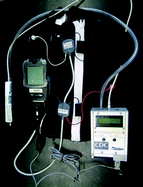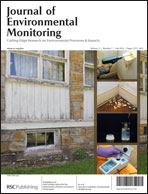Laboratory evaluation of a physiologic sampling pump (PSP)†
Abstract
Recently, physiologic sampling pumps (PSPs), which can adjust their sampling rates in proportion to wearers’ minute ventilation (![[V with combining dot above]](https://www.rsc.org/images/entities/i_char_0056_0307.gif) E), have been proposed to better estimate exposure to airborne contaminants in the workplace. A laboratory evaluation was conducted to compare the performance of a new
E), have been proposed to better estimate exposure to airborne contaminants in the workplace. A laboratory evaluation was conducted to compare the performance of a new ![[V with combining dot above]](https://www.rsc.org/images/entities/i_char_0056_0307.gif) E is highly correlated with
E is highly correlated with


 Please wait while we load your content...
Please wait while we load your content...